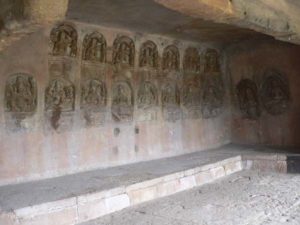About Khandagiri & Udayagiri
Udayagiri and Khandagiri Caves are partly natural and partly artificial caves of archaeological, historical and religious importance near the city of Bhubaneswar in Khordha district of Orissa. The caves are situated on two hills Udayagiri and Khandagiri, mentioned as Kumari Parvat in Hathigumpha Inscription and face each other across the road. They have a number of finely and ornately carved caves. It is believed that most of these caves were carved out of huge residential blocks for the Jain monks, during the reign of King Kharavela. Udayagiri meaning Sunrise Hill, has 18 caves while Khandagiri has 15 caves.
The caves of Udayagiri and Khandagiri, called Lena in the inscriptions, were dug out mostly during the reign of Kharavela for the abode of Jaina ascetics. The most important of this group is Ranigumpha in Udayagiri which is a double storeyed monastery.
Udayagiri
Cave 1
The
Rani Gumpha, on the path to the right, is the largest and most impressive of the caves. It is a double-storied monastery cut on three sides of a quadrangle with fine wall friezes and some pillars that have been restored. The right wing of the lower storey has pilasters at the entrance to the cell and the arches are beautifully carved with religious and royal scenes while the main central wing celebrates the king’s victory march. There are two small guard rooms with decorative outer walls. In the upper storey, the doorway arches to the cells are ornately carved; auspicious Jain symbols (snake and lotus) appear among vivid secular friezes of a woman’s abduction, an elopement, and a duel between a man and a woman.
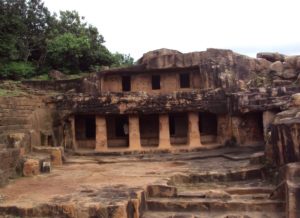
Cave 10
Ganesh Gumpha, about 50 m from the top of the hill, guarded by Ganesh statues, has friezes illustrating the Sanskrit love story of Udayan and Bassavadatta. From Cave 10 head up the path to the left, where an apsidal structure was unearthed in 1958. It is very similar to a Buddhist chaitya hall in plan and it was almost certainly a place of worship used by Jain monks.

Cave 14
The last important cave on Udayagiri, the Hathi Gumpha (Elephant Cave), has the most important inscription, that of King Kharavela. Protected by a masonry shelter since 1902, it is in the Magadhi script.
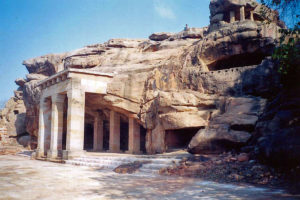
Khandagiri-
Caves 1 and 2
Known as
Tatowa Gumpha from the parrots carved above their door arches. Two sentries in dhotis guard Cave 1 which bears the name Kusuma. Modern steps lead up to the more elaborately carved Cave 2 on the left. On the back of the cell are Brahmi inscriptions in red pigment (first century BC to first century AD), obscured by modern Orissan graffiti.
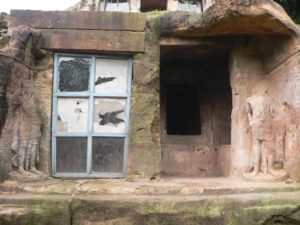
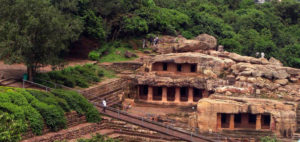
Cave 7
Navamuni Gumpha, named after the nine Tirthankaras (munis) carved on the back and right walls, was originally a residential cell. On the back wall of the original right hand cell are seven Tirthankaras in high relief including Parsvanatha under a seven- hooded canopy, and Risabanatha with a halo, seated on a bull.There are lovely carvings of Digambara Jains on the back wall of the shrine with a corrugated iron roof half way up to the Jain temple at the top, from where there are excellent views.
